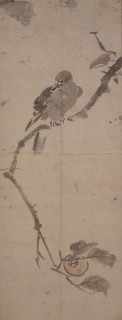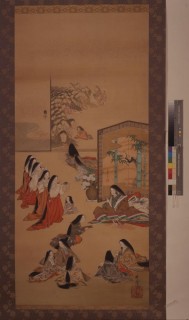Loading
Search
▼ Exhibit Features Paintings by Pioneering Father, Daughter
- Category:Event
“Kyosai and Kyosui — The Soul of the Artists as Pioneered by Father and Daughter,” is an exhibition currently being held at Tokyo Fuji Art Museum. It serves as a precious opportunity not only to enjoy the wide range of talents possessed by Kawanabe Kyosai (1831-1889), who flourished from the last years of the Edo era to the Meiji era, but also to see works by his daughter, Kyosui (1868-1935), who carried on the styles pioneered by her father.
Kyosai learned painting techniques from Utagawa Kuniyoshi, an ukiyoe artist, and professional painters belonging to the Kano-ha school. He is known for his versatility, creating not only traditional Japanese paintings mainly featuring beauty of nature, but also ukiyoe, giga caricatures and Western-style works.
Items shown in the exhibition include “Wind God and Thunder God,” which is painted on a pair of hanging scrolls — on display until May 13 — and the humorous “Fart Battle.”
About 160 of Kyosai’s works are being exhibited in rotation, to show pieces from categories he mastered.
As a child, Kyosui was taught to paint by her father. She accomplished a great deal as a pioneer of female painters. Later, she became the first female professor of Japanese painting at the Private Women’s School of Fine Arts, now Joshibi University of Art and Design.
Kyosai learned painting techniques from Utagawa Kuniyoshi, an ukiyoe artist, and professional painters belonging to the Kano-ha school. He is known for his versatility, creating not only traditional Japanese paintings mainly featuring beauty of nature, but also ukiyoe, giga caricatures and Western-style works.
Items shown in the exhibition include “Wind God and Thunder God,” which is painted on a pair of hanging scrolls — on display until May 13 — and the humorous “Fart Battle.”
About 160 of Kyosai’s works are being exhibited in rotation, to show pieces from categories he mastered.
As a child, Kyosui was taught to paint by her father. She accomplished a great deal as a pioneer of female painters. Later, she became the first female professor of Japanese painting at the Private Women’s School of Fine Arts, now Joshibi University of Art and Design.
“Pigeon on a Persimmon Tree,” an ink painting featuring in the exhibition, was done by Kyosai and given to Kyosui as a model picture for learning when she was 5 (in the East Asian method of counting ages).
It is said that Kyosui could not paint well at the time and shed tears over it. She hung the painting in her atelier even in the late years of her life, apparently so as not to forget those early feelings.
Kyosai recognized Kyosui’s talent and let her assist with his production. This is described in Kyosai’s illustrated diaries, but can also be understood from the works shown in the exhibition.
“Annual Events of Twelve Months” was a collaborative work by the two on an equal footing, with Kyosai drawing pictures of events from January to June and Kyosui doing the remaining months. The set of paintings will be exhibited from May 15.
Although “Banquet of a Hundred Merry Women” is signed by Kyosai, it was produced by Kyosui. This work will also be exhibited from May 15.
Though Kyosai’s pieces have been exhibited many times in recent years due to a reassessment of his work, there have been fewer opportunities to see Kyosui’s art.
This exhibition, however, shows about 80 of her works — the largest number so far. They illustrate how Kyosui worked in a wide range of painting categories, like her father, including Buddhist paintings, genre paintings and giga.
It is said that Kyosui could not paint well at the time and shed tears over it. She hung the painting in her atelier even in the late years of her life, apparently so as not to forget those early feelings.
Kyosai recognized Kyosui’s talent and let her assist with his production. This is described in Kyosai’s illustrated diaries, but can also be understood from the works shown in the exhibition.
“Annual Events of Twelve Months” was a collaborative work by the two on an equal footing, with Kyosai drawing pictures of events from January to June and Kyosui doing the remaining months. The set of paintings will be exhibited from May 15.
Although “Banquet of a Hundred Merry Women” is signed by Kyosai, it was produced by Kyosui. This work will also be exhibited from May 15.
Though Kyosai’s pieces have been exhibited many times in recent years due to a reassessment of his work, there have been fewer opportunities to see Kyosui’s art.
This exhibition, however, shows about 80 of her works — the largest number so far. They illustrate how Kyosui worked in a wide range of painting categories, like her father, including Buddhist paintings, genre paintings and giga.
Kyosui’s qualities as a painter really shine through in her bijin-ga, or portraits of beauties. One of them is “Beauty in the Kan’ei Era,” which is on display until May 13.
The work is shown together with a sketch drawn by Kyosai. The comparison shows the elegance and supple nature of Kyosui’s painting. The portrait is drawn with thin, flowing lines, the patterns on the kimono are highly precise, and viewers can see her superlative use of color.
There are also many paintings drawn by the father and daughter with the same motifs. Comparing them confirms that Kyosui was not satisfied with just following the path created by her great father, but pursued her own painting style. Her enthusiasm as a painter and artist is clear.
■“Kyosai and Kyosui — The Soul of the Artists as Pioneered by Father and Daughter” runs through June 24 at Tokyo Fuji Art Museum in Hachioji, Tokyo (closed on Mondays). Visit www.fujibi.or.jp/en/index
The work is shown together with a sketch drawn by Kyosai. The comparison shows the elegance and supple nature of Kyosui’s painting. The portrait is drawn with thin, flowing lines, the patterns on the kimono are highly precise, and viewers can see her superlative use of color.
There are also many paintings drawn by the father and daughter with the same motifs. Comparing them confirms that Kyosui was not satisfied with just following the path created by her great father, but pursued her own painting style. Her enthusiasm as a painter and artist is clear.
■“Kyosai and Kyosui — The Soul of the Artists as Pioneered by Father and Daughter” runs through June 24 at Tokyo Fuji Art Museum in Hachioji, Tokyo (closed on Mondays). Visit www.fujibi.or.jp/en/index
- May 17, 2018
- Comment (0)
- Trackback(0)




